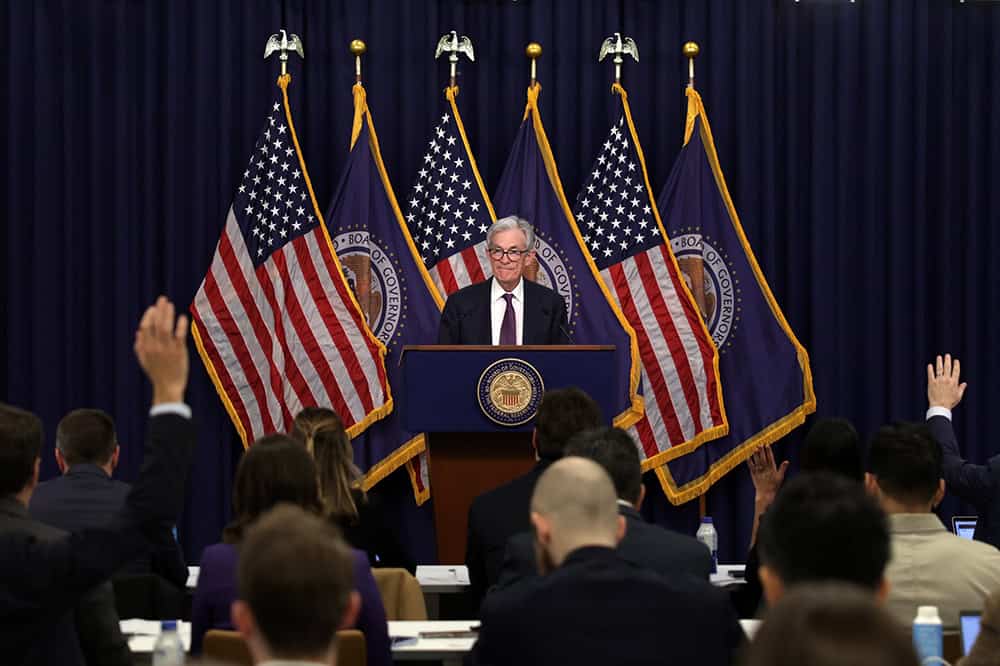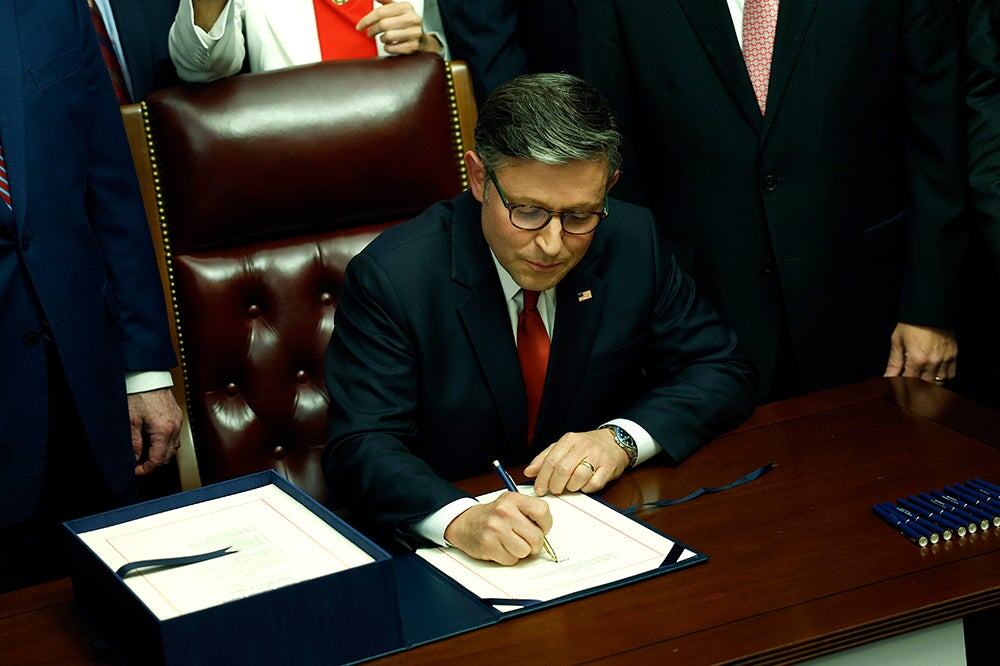U.S. Fiscal Confidence Falls as Nation Faces Higher Inflation and Unsustainable Budget Outlook
The April 2022 Fiscal Confidence Index, Modeled after the Consumer Confidence Index, is 42 (100 is Neutral)
NEW YORK (April 28, 2022) — U.S. Fiscal confidence fell in April, amidst news of inflation rising 8.5%, the largest annual increase in more than 40 years. The Peter G. Peterson Foundation’s April Fiscal Confidence Index, modeled after the Consumer Confidence Index, is 42 (100 is neutral), reflecting heightened voter concern about the latest economic indicators, including high inflation, Fed interest rate hikes, and America’s unsustainable federal debt and budget outlook.
More than four-in-five voters (82%) want the president and Congress to spend more time addressing the national debt, up three points from last month, and the same percentage say that their concern about the debt has increased. Across party lines, the vast majority of voters (77%) believe the national debt should be a top-three priority for the president and Congress, including 71% of Democrats, 74% of independents and 87% of Republicans.
“As we continue to face significant economic turbulence and uncertainty, fiscal confidence is near a record low, because voters know that our growing national debt makes it more difficult to build a strong and stable future,” said Michael A. Peterson, CEO of the Peterson Foundation. “The Federal Reserve is rightly acting to tame skyrocketing inflation, but higher interest rates will mean higher interest costs on our enormous national debt burden. Interest will soon become the fastest ‘program’ in the federal budget, which only means less resources available for important investments in our future. Leaders must begin the process of addressing these critical budget issues to build a more sustainable future for Americans.”
The Fiscal Confidence Index measures public opinion about the national debt by asking six questions in three key areas:
- CONCERN: Level of concern and views about the direction of the national debt.
- PRIORITY: How high a priority addressing the debt should be for elected leaders.
- EXPECTATIONS: Expectations about whether the debt situation will get better or worse in the next few years.
The survey results from these three areas are weighted equally and averaged to produce the Fiscal Confidence Index value. The Fiscal Confidence Index, like the Consumer Confidence Index, is indexed on a scale of 0 to 200, with a neutral midpoint of 100. A reading above 100 indicates positive sentiment. A reading below 100 indicates negative sentiment.
Fiscal Confidence Index Key Data Points:
- The April 2022 Fiscal Confidence Index value is 42. (The March value was 44. The February value was 42.)
- The current Fiscal Confidence Index score for CONCERN about the debt is 39, indicating deep concern about the debt. The score for debt as a PRIORITY that leaders must address is 26, indicating that Americans want elected leaders to make addressing long-term debt a high priority. The score for EXPECTATIONS about progress on the debt is 62. The Fiscal Confidence Index is the average of these three sub-category scores.
- For a description of the complete methodology, see the Appendix below.
The Peter G. Peterson Foundation commissioned this poll by the Global Strategy Group and North Star Opinion Research to survey public opinion on the national debt. The online poll included 1,000 registered voters nationwide, surveyed between April 18, 2022 and April 20, 2022. The poll has a margin of error of +/- 3.1%. The poll examined voters’ opinions on the national debt, political leadership, and America’s fiscal and economic health.
Detailed poll results can be found online at: www.pgpf.org/FiscalConfidenceIndex.
About the Peter G. Peterson Foundation
The Peter G. Peterson Foundation is a nonprofit, nonpartisan organization that is dedicated to increasing public awareness of the nature and urgency of key fiscal challenges threatening America’s future, and to accelerating action on them. To address these challenges successfully, we work to bring Americans together to find and implement sensible, long-term solutions that transcend age, party lines and ideological divides in order to achieve real results. To learn more, please visit www.pgpf.org.
APPENDIX: Fiscal Confidence Index Methodology and Questions
- The Fiscal Confidence Index is released monthly by the Peter G. Peterson Foundation.
- The Fiscal Confidence Index value is based on six questions in three categories.
- As is done with the Consumer Confidence Index, the first step in calculating the Fiscal Confidence Index is determining the “Relative Value” for each question. This calculation is made by taking the positive response for each question and dividing it by the sum of the positive and negative responses. Each question was asked on a four-point scale, and answers were weighted according to intensity, with the strongest responses counting twice as much as the middle responses (“much” better or worse answers count twice as heavily as “somewhat” better or worse answers).
- The scores for the Concern, Priority, and Expectations categories are determined by averaging the scores derived from the two questions in each category.
- The Fiscal Confidence Index value is converted from the Relative Value to place it on a scale on which 100 indicates equal positive and negative sentiment, while values below 100 indicate negative sentiment and values above 100 indicate positive sentiment.
- The questions are as follows:
| CONCERN (39) | |||
|---|---|---|---|
| Thinking about our national debt over the last few years, would you say your level of concern has increased or decreased? ◊ Is that a lot or just a little? |
April 2022 | March 2022 | February 2022 |
| Increased a lot | 54% | 55% | 51% |
| Increased a little | 28% | 28% | 27% |
| Decreased a little | 5% | 4% | 5% |
| Decreased a lot | 3% | 2% | 3% |
| (No change) | 7% | 7% | 10% |
| (Don’t Know/Refused) | 3% | 3% | 4% |
| INCREASED (NET) | 82% | 83% | 7% |
| DECREASED (NET) | 8% | 6% | 9% |
| When it comes to addressing our national debt, would you say things in the United States are heading in the right direction or do you think things are off on the wrong track? ◊ Do you feel that way strongly or just somewhat? |
April 2022 | March 2022 | February 2022 |
| Right direction — Strongly | 12% | 14% | 10% |
| Right direction — Somewhat | 22% | 20% | 22% |
| Wrong track — Somewhat | 22% | 25% | 24% |
| Wrong track — Strongly | 40% | 37% | 38% |
| (Neither/Mixed) | 1% | 1% | 2% |
| (Don’t Know/Refused) | 3% | 3% | 4% |
| RIGHT DIRECTION (NET) | 34% | 34% | 32% |
| WRONG TRACK (NET) | 63% | 61% | 62% |
| PRIORITY (26) | |||
|---|---|---|---|
| Some people say that addressing the national debt should be among the president and Congress’ top 3 priorities. Do you agree or disagree? ◊ Do you feel that way strongly or just somewhat? |
April 2022 | March 2022 | February 2022 |
| Strongly agree | 52% | 54% | 50% |
| Somewhat agree | 25% | 22% | 26% |
| Somewhat disagree | 13% | 14% | 13% |
| Strongly disagree | 5% | 5% | 7% |
| (Don’t Know/Refused) | 5% | 5% | 5% |
| AGREE (NET) | 77% | 76% | 76% |
| DISAGREE (NET) | 18% | 19% | 20% |
| And when it comes to our national debt, do you think it is an issue that the president and Congress should spend more time addressing or less time addressing? ◊ Would you say a lot (more or less) time or just a little? |
April 2022 | March 2022 | February 2022 |
| A lot more time | 50% | 46% | 47% |
| A little more time | 32% | 32% | 32% |
| A little less time | 7% | 8% | 7% |
| A lot less time | 5% | 5% | 6% |
| (The same amount of time) | 2% | 4% | 3% |
| (Don’t Know/Refused) | 4% | 5% | 5% |
| MORE TIME (NET) | 82% | 79% | 79% |
| LESS TIME (NET) | 12% | 13% | 13% |
| EXPECTATIONS (62) | |||
|---|---|---|---|
| And thinking about our national debt over the next few years, do you expect the problem to get better or worse? ◊ Is that much (better or worse) or just somewhat (better or worse)? |
April 2022 | March 2022 | February 2022 |
| Much better | 9% | 10% | 7% |
| Somewhat better | 18% | 18% | 17% |
| Somewhat worse | 27% | 31% | 31% |
| Much worse | 39% | 35% | 38% |
| (No change) | 2% | 2% | 2% |
| (Don’t know/Refused) | 3% | 4% | 4% |
| BETTER (NET) | 28% | 28% | 25% |
| WORSE (NET) | 67% | 66% | 69% |
| And when it comes to our national debt, are you optimistic or pessimistic that the United States will be able to make progress on our national debt over the next few years? ◊ Would you say you are very (optimistic or pessimistic) or just somewhat? |
April 2022 | March 2022 | February 2022 |
| Very optimistic | 7% | 8% | 7% |
| Somewhat optimistic | 31% | 33% | 30% |
| Somewhat pessimistic | 32% | 30% | 32% |
| Very pessimistic | 25% | 23% | 26% |
| (Neither/Mixed) | 2% | 3% | 3% |
| (Don’t Know/Refused) | 3% | 3% | 3% |
| OPTIMISTIC (NET) | 39% | 41% | 37% |
| PESSIMISTIC (NET) | 57% | 53% | 58% |
Further Reading
Quiz: How Much Do You Know About Healthcare in the United States?
The United States has one of the largest and most complex healthcare systems in the world. Take our healthcare quiz to see how much you know about the cost and quality of the U.S. healthcare system.
The Fed Reduced the Short-Term Rate Again, but Interest Costs Remain High
High interest rates on U.S. Treasury securities increase the federal government’s borrowing costs.
How Did the One Big Beautiful Bill Act Change Tax Policy?
See how OBBBA restructured the tax landscape across four major areas: individual tax provisions, business tax provisions, energy tax credits, and health-related tax changes.


